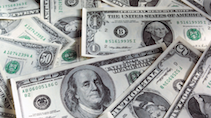The US Federal Reserve on Wednesday raised interest rates by 0.75% in the biggest increase since 1994, and chair Jerome Powell signaled another big move next month.
The central bank increased its effort to fight inflation by lifting the target range for the federal funds rate to 1.5% to 1.75%.
Powell said another 75 basis-point hike, or a 50 basis-point move, was likely at the next meeting of policy makers.
Policy makers forecast that interest rates would rise further this year, to 3.4% by December and to 3.8% by the end of 2023.
“Clearly, today’s 75 basis-point increase is an unusually large one and I do not expect moves of this size to be common,” said Powell.
The Federal Open Market Committee (FOMC) statement said: “The Committee seeks to achieve maximum employment and inflation at the rate of 2 percent over the longer run.
“In support of these goals, the Committee decided to raise the target range for the federal funds rate to 1‑1/2 to 1-3/4 percent and anticipates that ongoing increases in the target range will be appropriate.
“In addition, the Committee will continue reducing its holdings of Treasury securities and agency debt and agency mortgage-backed securities, as described in the Plans for Reducing the Size of the Federal Reserve’s Balance Sheet that were issued in May.
“The Committee is strongly committed to returning inflation to its 2 percent objective.
“In assessing the appropriate stance of monetary policy, the Committee will continue to monitor the implications of incoming information for the economic outlook.
“The Committee would be prepared to adjust the stance of monetary policy as appropriate if risks emerge that could impede the attainment of the Committee’s goals.”
Wall Street rallied amid the assurance that large hikes would not be common.
The S&P 500 climbed 1.5% and Treasury yields eased in the bond market.
The Dow Jones Industrial Average closed up 1% and the Nasdaq rose 2.5%.
REACTION:
James Athey, investment director, Abrdn: “By the Fed’s own definitions their policy operates largely through financial conditions.
“The opening lines of Chair Powell’s press conference took an aggressive looking hike and wrapped it in sufficient caution and nuance that rates are falling, causing a decline in the dollar and a significant rise in equities.
“This is a meaningful easing of financial conditions — the exact opposite of the Fed’s intentions today.
“This looks like an unnecessary own goal.”
Yung-Yu Ma, chief investment strategist at BMO Wealth Management: “Chair Powell painted as rosy a picture as could be painted, and to achieve that picture that he is laying out, that pathway, a lot has to go right.
“It’s a challenging path, and he acknowledged that …
“Nothing has gone away, nothing looks like it is meaningfully closer to the end game.
“It still seems like everything is at best highly uncertain.”
Richard Carter, head of fixed interest research at Quilter Cheviot: “The Federal Reserve has decided now is the time to up its aggressiveness in the battle against inflation.
“Choosing to raise interest rates by 75bps looks justified given the unrelenting inflation pressures being seen in the US at the moment.
“Last week’s inflation print caught people by surprise and it has been disappointing not to see inflation start to fallout the system.
“There is no doubt that the Fed got themselves behind the curve on inflation and are now having to make up for lost time and we expect to see several more rate hikes before the year is out.
“Inflation has been stickier and more persistent than was expected, so it is unlikely now that this problem will simply just dissipate quickly over the second half of the year.
“High oil prices continue to keep inflation elevated and there are fears that as China switches back on following various lockdowns we will get another demand shock and this could make inflation remain stubborn.
“Investors are understandably concerned that such a sharp pace of monetary tightening will lead to a recession and markets are likely to remain volatile until we reach a peak in inflation.
“In the near term equity markets, and in particular growth companies, are unlikely to react well to this news, while bond yields will continue to trace higher for as long as inflation remains an issue the Fed feels it needs to specifically attack.
“While the current market is difficult for investors, what this does show is the importance of having a well-diversified portfolio and the protection it can provide.”
Quincy Krosby, chief equity strategist for LPL Financial: “He’s making it extremely clear to the market, to U.S. consumers, that the Fed takes this seriously and is doing whatever it takes to take inflation down and maintain price stability.”
Jeffrey Frankel, co-president at Stuart Frankel & Co: “It was what everyone was expecting.
“What Powell is saying after the announcement, that he will be flexible about future rate hikes, the market seems happy at the moment.”
